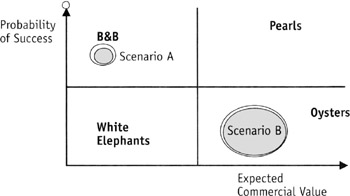The Emphasis on Portfolio Management: Cross-Learning and Real-Option Market
|
Finally, intense innovation strategies call for a renewed interest in portfolio management logic as a specific level of analysis to take into account. In the 1990s, modern development project management as "heavy weight project structures" (Clark 1991) emphasized integration and valuation of existing knowledge and energies into projects. The major challenge for intensive innovation strategies is to move from mobilization on single projects, to global management of bunches and series of projects along innovation trajectories (Ben Mahmoud-Jouini 2000) or lineage (Hatchuel 1999) of products. The increase of risk level for each isolated project is another argument for focussing on portfolio management, as observed in the pharmaceutics (Cooper 1998; Sharpe 1998). Last but not least, the increased allocation of resources to R&D and the strategic importance of innovative performance create new constraints in terms of communication on R&D projects portfolios.
This perspective emphasizes the multiple interdependencies and potential externalities of project processes, whereas the single management project view considers only the cash results obtained at the end of the projects. Such an approach focuses on:
-
Reconsidering the evaluation of individual projects with respect to the global portfolio, in terms of global risk and profit profile, continuity, and smoothness of expected revenues as consumption of spare resources.
-
Organizing the cross-project learning of technological aspects and market opportunities (Ayas 1997; Charue-Duboc 1999).
-
Considering the possibility of "trading", buying, or selling projects (wholly or partly) at different stages in their development. The relevant business model is modified to take into account the management of the R&D portfolio.
That last perspective forces us to reconsider the traditional vision of the R&D portfolio as a "funnel" to an image that we might describe as a "porous funnel" (Bayart 1999), leaving room for trading with other firms as shown in Figure 4.

Figure 4: The R&D Process: From "Conventional Funnel" Metaphor to "Porous Funnel"
The decisional framework for R&D management in porous funnel mode is significantly different from that associated with the conventional funnel, as Table 1 shows.
| Conventional Funnel Situation | Porous Funnel Situation | |
|---|---|---|
| Resource allocation is based on sharing out a fixed overall budget (zero-sum game between projects) | =/= | The overall budget varies according to the decisions reached (nonzero-sum game) |
| Projects are evaluated according to defined corporate norms | =/= | Each project has an inter-firm trade value that may differ from its value for the originating company |
| Gaining value from the project is based on the expertise of downstream sales personnel | =/= | Gaining value from the project is an ongoing activity from the outset and is based on R&D expertise |
In that perspective, conventional analysis of project portfolios in a risk/attractiveness "bubble-diagrams" graphic (Cooper 1998) has to be reconsidered because the same project may be positioned at two very different locations, as is shown in Figure 5.

Figure 5: The Representation of Various Scenarios Associated with the Same Project in a "Bubble Diagram" Representation on Conventional Type
In Figure 5, at bottom right, the representation picturing internal development implies high risk and investment, while promising large profits in the event of success. At top left is the assessment of the same project if value is gained from it during development by means of a trade with another pharmaceutical firm. Specifically, the risk and the investment are smaller (because return on the project is immediate and simultaneous with the trade, and the other firm will complete the development), but the profit in the event of success is obviously lower (sale price plus royalties on any future sales for example).
Such an emphasis on a global portfolio management issue is not to be interpreted as a coming back to functional structures that pre-existed to the development of project management structures. It has to be considered, on the contrary, as a new step in order to take into account, and if possible conciliate, the temporary and durable identities of the modern business society.
To conclude, the four above points raise important problems when the traditional project management approach is being implemented to support intensive innovation strategies. In this communication, we have indicated tracks to address these problems by referring to organizational and business theories. Analysis of such issues appears a fruitful opportunity for cross-disciplinary theoretical exchanges as for cooperation between scholars and practitioners. The creation of research networks such as the International Research Network on Organizing by Projects (IRNOP) and PRAMECO help as the research currently under way with major European firms try to materialize this opportunity (A French research network on analyzing the ongoing transitions in R&D practices and professions. It gathers researchers who share an interactive methodology in various scientific fields: organization and management, engineering, sociology, ergonomics, and cognitive psychology).
|
EAN: 2147483647
Pages: 207